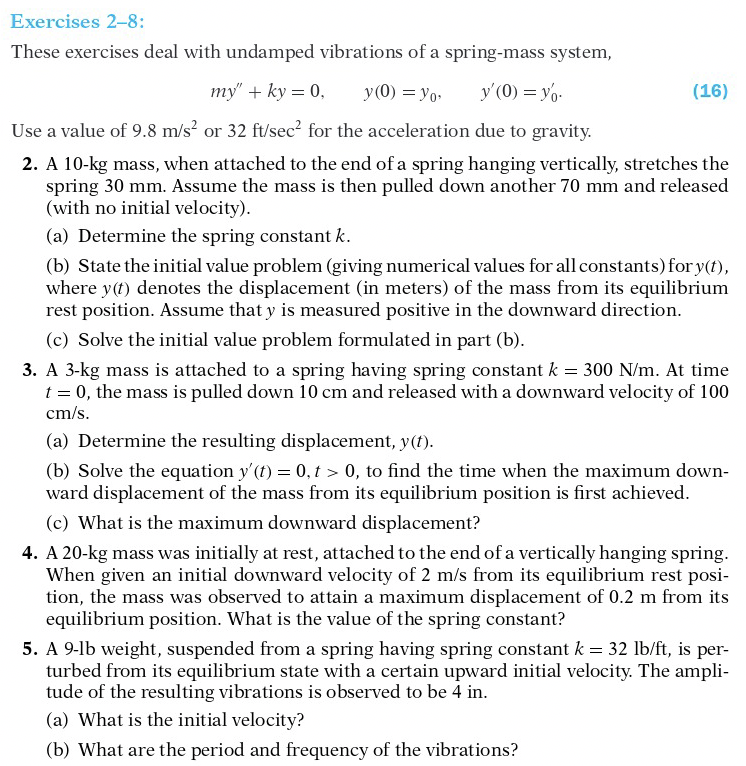3. A 3-kg mass is attached to a spring having spring constant k = 300 N/m. At time t = 0, the mass is pulled down 10 cm and released with a downward velocity of 100 cm/s. (a) Determine the resulting displacement, y(t). (b) Solve the equation y'(f) = 0, t > 0, to find the time when the maximum down- ward displacement of the mass from its equilibrium position is first achieved. (c) What is the maximum downward displacement?
3. A 3-kg mass is attached to a spring having spring constant k = 300 N/m. At time t = 0, the mass is pulled down 10 cm and released with a downward velocity of 100 cm/s. (a) Determine the resulting displacement, y(t). (b) Solve the equation y'(f) = 0, t > 0, to find the time when the maximum down- ward displacement of the mass from its equilibrium position is first achieved. (c) What is the maximum downward displacement?
Linear Algebra: A Modern Introduction
4th Edition
ISBN:9781285463247
Author:David Poole
Publisher:David Poole
Chapter6: Vector Spaces
Section6.7: Applications
Problem 18EQ
Related questions
Question
Please do #3
section 3.6

Transcribed Image Text:Exercises 2-8:
These exercises deal with undamped vibrations of a spring-mass system,
my" + ky = 0,
y(0) = yo-
y'(0) = yo.
(16)
Use a value of 9.8 m/s? or 32 ft/sec? for the acceleration due to gravity.
2. A 10-kg mass, when attached to the end of a spring hanging vertically, stretches the
spring 30 mm. Assume the mass is then pulled down another 70 mm and released
(with no initial velocity).
(a) Determine the spring constant k.
(b) State the initial value problem (giving numerical values for all constants) for y(t),
where y(t) denotes the displacement (in meters) of the mass from its equilibrium
rest position. Assume that y is measured positive in the downward direction.
(c) Solve the initial value problem formulated in part (b).
3. A 3-kg mass is attached to a spring having spring constant k = 300 N/m. At time
t = 0, the mass is pulled down 10 cm and released with a downward velocity of 100
cm/s.
(a) Determine the resulting displacement, y(t).
(b) Solve the equation y'(f) = 0, t > 0, to find the time when the maximum down-
ward displacement of the mass from its equilibrium position is first achieved.
(c) What is the maximum downward displacement?
4. A 20-kg mass was initially at rest, attached to the end of a vertically hanging spring.
When given an initial downward velocity of 2 m/s from its equilibrium rest posi-
tion, the mass was observed to attain a maximum displacement of 0.2 m from its
equilibrium position. What is the value of the spring constant?
5. A 9-lb weight, suspended from a spring having spring constant k = 32 lb/ft, is per-
turbed from its equilibrium state with a certain upward initial velocity. The ampli-
tude of the resulting vibrations is observed to be 4 in.
(a) What is the initial velocity?
(b) What are the period and frequency of the vibrations?
Expert Solution
This question has been solved!
Explore an expertly crafted, step-by-step solution for a thorough understanding of key concepts.
This is a popular solution!
Trending now
This is a popular solution!
Step by step
Solved in 4 steps with 4 images

Recommended textbooks for you

Linear Algebra: A Modern Introduction
Algebra
ISBN:
9781285463247
Author:
David Poole
Publisher:
Cengage Learning

Linear Algebra: A Modern Introduction
Algebra
ISBN:
9781285463247
Author:
David Poole
Publisher:
Cengage Learning